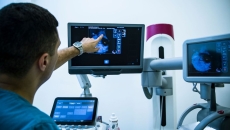Population and Public Health
HIMSS23
Dana Trampas, senior digital health specialist at HIMSS, shares how healthcare organizations can promote and advocate for LGBTQ health equity and inclusion within their patient populations and their workforces.
HIMSS23
Natasha Ramontal, HIMSS digital health strategist for community outcomes and analytics, describes how the Community Care Outcomes Maturity Model (C-COMM) engages and empowers patients by supporting meaningful care relationships.
HIMSS23
Lawrence Whittle, CCO at Verana Health, describes how patient data can be used to improve healthcare, including making clinical trials more efficient and helping clinicians discover which treatments yield the most value.
HIMSS23
Dr. John Showalter, CPO at Linus Health, describes drug therapy advances for Alzheimer's and how technology can help screen and identify at-risk patients sooner to optimize outcomes and quality of life.
HIMSS23
Dr. Jay Bhatt, managing director at Deloitte, shares recommendations on how businesses can realize productivity and retention benefits by boosting health equity for their employees.
HIMSS23
Joana Feijó, business development director for Health Cluster Portugal, describes how Portugal is using lessons learned from other countries to modernize its own digital healthcare infrastructure.
In a letter to employees, CEO Ayub Khattak said the diagnostics company's new initiatives are "progressing well but are still early in terms of revenue generation."
HIMSS23
Anna Schoenbaum, VP of information services at Penn Medicine, discusses the significance of technology for addressing social determinants of health, as well as how regulations mandate the use and collection of SDOH data.
HIMSS23
J29 president and founder Tracy Mills and VP of HHS programs Nick Vass highlight the importance of state and federal agencies collaborating with private companies to better serve population health needs.
The group who received an interactive DVD and patient navigation services delivered by phone was nearly six times more likely to be up-to-date on breast, cervical and colorectal cancer screenings compared with a cohort who received usual care.









